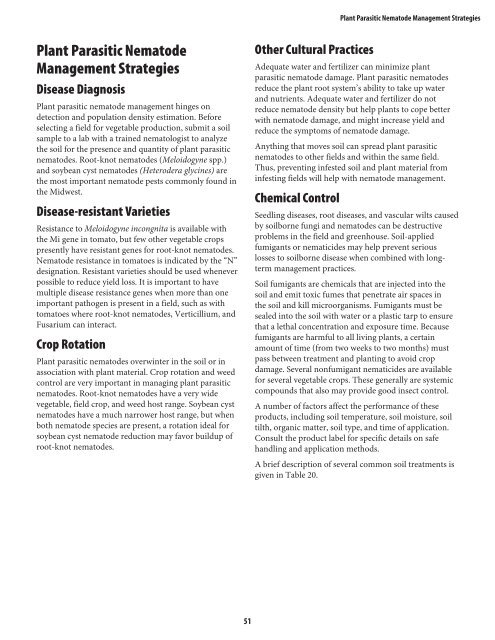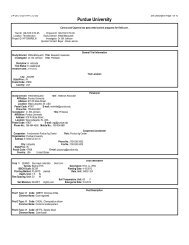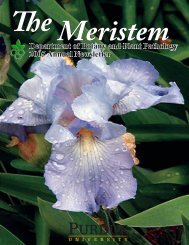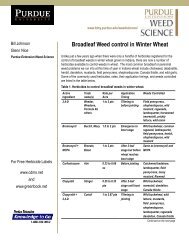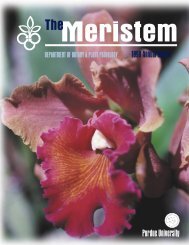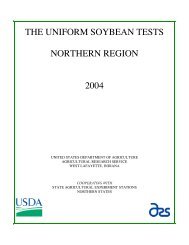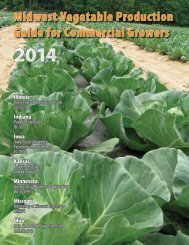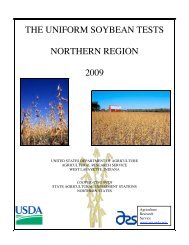Plant Parasitic Nematode Management Strategies
Plant Parasitic Nematode Management Strategies
Plant Parasitic Nematode Management Strategies
- No tags were found...
You also want an ePaper? Increase the reach of your titles
YUMPU automatically turns print PDFs into web optimized ePapers that Google loves.
<strong>Plant</strong> <strong>Parasitic</strong> <strong>Nematode</strong> <strong>Management</strong> <strong>Strategies</strong><strong>Plant</strong> <strong>Parasitic</strong> <strong>Nematode</strong><strong>Management</strong> <strong>Strategies</strong>Disease Diagnosis<strong>Plant</strong> parasitic nematode management hinges ondetection and population density estimation. Beforeselecting a field for vegetable production, submit a soilsample to a lab with a trained nematologist to analyzethe soil for the presence and quantity of plant parasiticnematodes. Root-knot nematodes (Meloidogyne spp.)and soybean cyst nematodes (Heterodera glycines) arethe most important nematode pests commonly found inthe Midwest.Disease-resistant VarietiesResistance to Meloidogyne incongnita is available withthe Mi gene in tomato, but few other vegetable cropspresently have resistant genes for root-knot nematodes.<strong>Nematode</strong> resistance in tomatoes is indicated by the “N”designation. Resistant varieties should be used wheneverpossible to reduce yield loss. It is important to havemultiple disease resistance genes when more than oneimportant pathogen is present in a field, such as withtomatoes where root-knot nematodes, Verticillium, andFusarium can interact.Crop Rotation<strong>Plant</strong> parasitic nematodes overwinter in the soil or inassociation with plant material. Crop rotation and weedcontrol are very important in managing plant parasiticnematodes. Root-knot nematodes have a very widevegetable, field crop, and weed host range. Soybean cystnematodes have a much narrower host range, but whenboth nematode species are present, a rotation ideal forsoybean cyst nematode reduction may favor buildup ofroot-knot nematodes.Other Cultural PracticesAdequate water and fertilizer can minimize plantparasitic nematode damage. <strong>Plant</strong> parasitic nematodesreduce the plant root system’s ability to take up waterand nutrients. Adequate water and fertilizer do notreduce nematode density but help plants to cope betterwith nematode damage, and might increase yield andreduce the symptoms of nematode damage.Anything that moves soil can spread plant parasiticnematodes to other fields and within the same field.Thus, preventing infested soil and plant material frominfesting fields will help with nematode management.Chemical ControlSeedling diseases, root diseases, and vascular wilts causedby soilborne fungi and nematodes can be destructiveproblems in the field and greenhouse. Soil-appliedfumigants or nematicides may help prevent seriouslosses to soilborne disease when combined with longtermmanagement practices.Soil fumigants are chemicals that are injected into thesoil and emit toxic fumes that penetrate air spaces inthe soil and kill microorganisms. Fumigants must besealed into the soil with water or a plastic tarp to ensurethat a lethal concentration and exposure time. Becausefumigants are harmful to all living plants, a certainamount of time (from two weeks to two months) mustpass between treatment and planting to avoid cropdamage. Several nonfumigant nematicides are availablefor several vegetable crops. These generally are systemiccompounds that also may provide good insect control.A number of factors affect the performance of theseproducts, including soil temperature, soil moisture, soiltilth, organic matter, soil type, and time of application.Consult the product label for specific details on safehandling and application methods.A brief description of several common soil treatments isgiven in Table 20.51
<strong>Plant</strong> <strong>Parasitic</strong> <strong>Nematode</strong> <strong>Management</strong> <strong>Strategies</strong>Table 20: <strong>Nematode</strong> Soil TreatmentsChemicalmethyl bromide(RUP)Mocap®, ethroprop(RUP)SMDC: sodiummethydithiocarbamate(Vapam®, etc.)Fumigant/NematicideFNFApplication <strong>Plant</strong> Back Time Crops CommentsPreplant, tarped, ormulched for 24-48 hours.Soil only. Applied withwater by soil injection,sprinkler system, floodirrigation, over soilsurface with sprinklingcan.Preplant tarped. Don’tenter within 48 hours.Vydate® (RUP) N Soil and foliagetreatment.10-14 days most vegetables Formulations with98% methyl bromideand 2% chloropicrinare appropriate fornematode control.14-21 days aftertreatmentNAcabbage, sweetcorn, cucumbers,potatoes, sweetpotatoes, snapbeans, lima beansgeneral usefumigantcarrots, celery,cucurbits,eggplants, peppers,potatoes, sweetpotatoes, tomatoesMobile in sand soils.Crop injury can occurif used in furrow.Vapam is moreeffective when appliedwith considerablewater.Foliar applicationsare not effectivefor moderate andhigh populations ofnematodes.Telone® (RUP) F Soil treatment only. 2-3 weeks most vegetables Formulations withhigh percentageschloropicrin areneeded to controlsoilborne fungaldiseases.Nemacur®,fenamiphos (RUP)F=fumigantN=nematicideRUP=restricted use pesticideN Soil treatment only. NA cabbage, Brusselssprouts, bok choy,okra, garlicBelowground symptoms of root knot nematodes include roots with enlarged galls.52


